Family Legacy Video is featured in this article about legacy planning in Investment News. I’m sure glad I picked up the phone when the reporter called!
You can read the article here.
Family Legacy Video is featured in this article about legacy planning in Investment News. I’m sure glad I picked up the phone when the reporter called!
You can read the article here.
I have a major jones for family stories. There, I’ve said it for the world to see. And you know what? I’m glad.
Looking back, I remember being drawn to personal history at an early age. My dad’s side of the family was pretty humongous, and throughout the years we’d attend picnics or holiday get-togethers at the homes of various aunts and uncles. I loved the food, and hanging out with my cousins. But my favorite time was always after we’d polished off the baked ziti and inhaled the pies, cakes and fruit salad. That was the time when the adults would settle down with brimming cups of coffee and reminisce about their lives and times and those of family members separated from us by mileage or the grim reaper.
The easy banter, the laughter, the rise and ebb of volume and energy as many voices gave way to one and then joined in again to relate other stories triggered by something just said; listening to my parents, grandparents, aunts and uncles during these late afternoon and early evening gab fests was just so – comforting. And there was also something about the relish with which my elders told their stories that made hearing their tales just plain fun. Yeah, I was hooked on family stories as a young ‘un.
Flashing forward, my undergraduate communications degree, plus a recommendation from a former college buddy, landed me a job in a New York City public relations firm specializing in the budding realm of video. I spent the next eight years and change learning to tell clients’ stories on video, first as a production assistant on shoots, and then as a video editor, writer, and producer/director. And when I got tired of sitting for hours on end in my company’s dark and cool edit suite, I launched a freelance career. I still spent lots of hours in editing suites, but at least there was variety, I got paid more, and I did get out into the sun more often.
But even though I enjoyed what I was doing, I felt, in my heart, that there should be something more that I could be doing with my skills. I even asked a psychic once if I would ever discover a higher purpose to which I could apply my video abilities. She said I would – although she wouldn’t or couldn’t tell me what form that higher purpose would take.
Enter my paternal grandmother, Alice Rita Morrissey Pender. Actually, Gram was part of my story all along. But in 1995 she would play a central role in helping me chart a new course for my life and career.
Gram was born on Staten Island, New York in 1911. She was blessed with a great memory and a gift for gab, and as I was growing up she shared oodles of stories about her life and our family. I learned how her grandparents emigrated from Ireland but didn’t meet until they were both living in New York City; about how her dad earned a ton of money in the storage battery business, only to lose it during the Great Depression and how he still managed to keep a roof over the family’s heads; there were stories about her grandfather, a police lieutenant stationed at New York City Hall, taking her into the city to witness ticker tape parades; the stories went on and on. And in addition to my enjoyment at hearing her tell them, I realize now that those life stories also grounded me. They gave me an insight into my family’s character (and characters), showed me where my family came from, where they fit into the world and how I fit into my family. Knowing those stories has given me an invaluable sense of identity that’s stayed with me throughout my life. Oh, by the way, I was her first grandchild, so I think we had a special bond because of that.
In 1995, I realized that Gram wouldn’t be around forever. I decided to try and capture her, and some of her stories, on video. Now, these were still the tape-to-tape days, when video editing was done in very expensive editing bays, so there was no way I could shoot and edit the project without a little help. Luckily, one of my corporate clients lent me the use of their video gear and editing suite and one of my colleagues kindly ran camera for me. And so it was that in 1995, I sat down with Gram in my Clifton, NJ, apartment and captured her on-camera, telling me those same wonderful stories I’d heard from her over the years.
Long story short: Due to procrastination and work demands, I didn’t tackle the editing until 1998. But that summer, I made a concerted push and finished what will always be one of my proudest achievements: a documentary featuring my grandmother telling the story of her life. Unfortunately, she died without seeing the video. I will always regret not hustling over to her the moment I wrapped work on her video to “premiere” it for her. But I also know that I’d never have been able to forgive myself if I hadn’t captured her, and her stories, for posterity.
So the first time the majority of my family saw Gram’s video biography was at the repast following her funeral. As you can imagine, my emotions took a roller coaster ride that day. But the video truly transformed a day of mourning into a celebration of life. After seeing the impact Gram’s legacy video had on my family that day and during the days that followed, the higher purpose I spoke of earlier began to reveal itself. More on that in another post. Thanks for reading.
Oh, and by the way: What’s your story?
Over the years, Family Legacy Video, Inc. has captured the attention of the print, TV and radio media. We’ve also garnered our share of awards! You can read about Family Legacy Video on the “Family Legacy Video in Print” page; listen to company president Steve Pender on the “Family Legacy Video on the Radio” page; and watch Steve’s recent TV appearances on the “Family Legacy Video on TV” page.
You can view the list of Family Legacy Video’s video biography honors on the “Family Legacy Video Awards” page.
The era of coast-to-coast passenger air service in the U.S. dawned on October 25, 1930, when the pilot of a Transcontinental & Western Air Ford Tri-Motor throttled up the plane’s three engines and lifted off from the runway in Newark, New Jersey. During the 36-hour trip, the plane stopped at Philadelphia, Harrisburg and Pittsburgh, Pennsylvania; Columbus, Ohio; Indianapolis, Indiana; St. Louis and Kansas City, Missouri. After overnighting in Kansas City, the plane continued on to Wichita, Kansas; Amarillo, Texas; Albuquerque, New Mexico; Winslow, Arizona and then to its final destination, Los Angeles, California. Talk about layovers!
On the Columbus to Indianapolis leg of that inaugural journey, the passenger list included a forty-three-year-old salesman for the Holcombe & Hoke Manufacturing Company named William Morrissey.
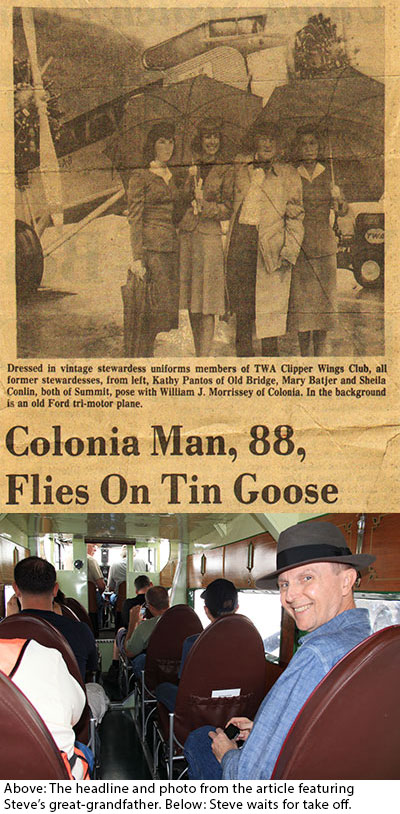 Exactly forty-five years later, on October 25, 1975, TWA (the successor to Transcontinental & Western Air) marked the anniversary of that flight with a celebration at Newark International Airport. On hand for the party were TWA officials, a vintage Ford Tri-Motor, former flight attendants sporting vintage uniforms, and my great-grandfather, William Morrissey, who was then living in Colonia, New Jersey.
Exactly forty-five years later, on October 25, 1975, TWA (the successor to Transcontinental & Western Air) marked the anniversary of that flight with a celebration at Newark International Airport. On hand for the party were TWA officials, a vintage Ford Tri-Motor, former flight attendants sporting vintage uniforms, and my great-grandfather, William Morrissey, who was then living in Colonia, New Jersey.
My great-grandfather spoke about his experiences flying in the “Tin Goose” to the assembled media, which included the local New York television stations and a reporter from the Star-Ledger newspaper.
I knew about my great-grandfather’s travels during the early days of commercial air flight and always wondered what that experience had been like. So, when I opened my local Tucson paper one morning to see an ad for flights in a restored Ford Tri-Motor, I knew my wife and I would be taking part.
I purchased tickets, and on Valentine’s Day of this year, Halina and I headed for the airport. The flights were conducted as a part of the “Fly the Ford” tour, sponsored by the Experimental Aircraft Association (EAA). Against a backdrop of modern passenger jets, we climbed aboard the triple-engine, corrugated metal bird, and buckled ourselves in. One by one, the engines roared to life, sending their noise and vibrations through the cabin. With a practiced hand, the pilot guided the ten-passenger plane to the runway and then into the air for a fifteen-minute cruise over Tucson. It was an absolute thrill, and a chance to connect, in a small way, with what my great-grandfather experienced so many years ago.
If you’d like to see a short video documenting our flight, you’ll find it in the March 2015 e-Newsletter.
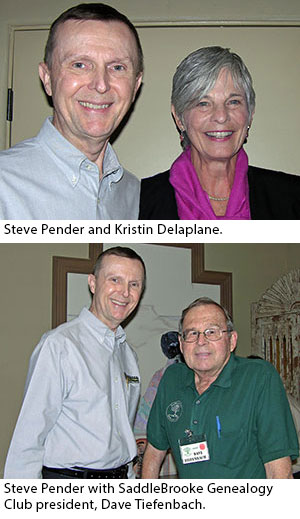 On January 8, 2015, Family Legacy Video’s president, Steve Pender, teamed with author and personal historian Kristin Delaplane for a presentation to the SaddleBrooke Genealogy Club in SaddleBrooke, Arizona, just a bit north of Tucson. Kristin is a recent transplant to Tucson and will release a book, Family History Secrets: The Complete Guide to Capturing Family Stories For Your Heirloom Book, in May of this year. SaddleBrooke Genealogy Club program chair Randy Gibbs found Kristin when searching for someone to address the group about creating print memoirs. Kristin felt the club members would also enjoy learning about options for preserving stories on video. Having discovered Family Legacy Video after moving to Tucson, she invited Steve Pender to share in the fun.
On January 8, 2015, Family Legacy Video’s president, Steve Pender, teamed with author and personal historian Kristin Delaplane for a presentation to the SaddleBrooke Genealogy Club in SaddleBrooke, Arizona, just a bit north of Tucson. Kristin is a recent transplant to Tucson and will release a book, Family History Secrets: The Complete Guide to Capturing Family Stories For Your Heirloom Book, in May of this year. SaddleBrooke Genealogy Club program chair Randy Gibbs found Kristin when searching for someone to address the group about creating print memoirs. Kristin felt the club members would also enjoy learning about options for preserving stories on video. Having discovered Family Legacy Video after moving to Tucson, she invited Steve Pender to share in the fun.
Club members received both speakers enthusiastically, even offering up a spirited round of applause after viewing the sample clips Steve played for them. Afterwards, many attendees remarked about how Steve’s talk opened their eyes to how they could use video to preserve the family stories of their loved ones.
Do you belong to a club, organization or a business in need of inspiring and informational speakers? If so, don’t hesitate to contact Steve Pender. He can craft 20-30 minute presentations for your breakfast, lunch or dinner meetings or even longer talks (and workshops) to fit your needs. And if you’d like a print component, Steve and Kristin are certainly willing to team up again!
“Imagine,” I suggested to the attentive group of seniors in front of me. “Imagine for a moment that video technology existed during your great-grandparents’ times and that one day they sat down and recorded the stories of their lives. Imagine also that you could sit down today and watch those video biographies. Wouldn’t that be wonderful?” The eyes of most of my audience widened as they nodded in assent. “Well,” I continued. “Video technology obviously didn’t exist back then. But it’s here today. And that means you can do something your great-grandparents couldn’t, which is to create a living, breathing, keepsake that preserves and celebrates your life stories, both to enjoy now and to leave as a precious gift for generations of your families yet to come.”
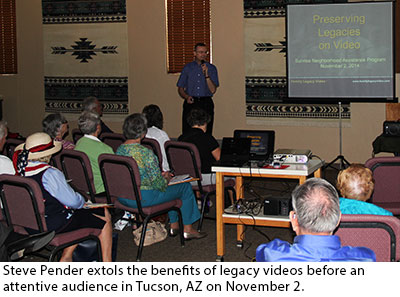 With those words, I was off and running on my latest presentation, as part of a Sunday afternoon program sponsored by the Sunrise Neighborhood Assistance Program of Tucson, Arizona. I explained just what a video biography was, described in a nutshell the process I use to create a legacy video and outlined the benefits of preserving personal stories in a video biography format. Most importantly, I showed several sample clips so attendees could see for themselves just how legacy videos look and sound – and see what the possibilities could be for them.
With those words, I was off and running on my latest presentation, as part of a Sunday afternoon program sponsored by the Sunrise Neighborhood Assistance Program of Tucson, Arizona. I explained just what a video biography was, described in a nutshell the process I use to create a legacy video and outlined the benefits of preserving personal stories in a video biography format. Most importantly, I showed several sample clips so attendees could see for themselves just how legacy videos look and sound – and see what the possibilities could be for them.
Helping to inform and inspire folks is part of my mission as president of Family Legacy Video, Inc. I realize that many folks don’t know what a video biography is and that they can pass along their life stories and values this way. I always enjoy introducing potential storytellers to the subject. It’s especially delightful when audience members approach me after a presentation to tell me some of their stories and discuss how they can start planning their legacy video. That tells me that they “get it” in terms of understanding the importance of sharing their experiences and wisdom with present and future members of their families.
I also find that when I detail the myriad benefits video legacy projects, I reinforce to myself the importance of the work I do as a personal historian – a valuable side benefit for me.
So if you have a group of folks who you think might like to learn about preserving, celebrating and sharing their life stories with their own personal video biographies, give me call or shoot me an e-mail. I’m only too happy to talk.
The afternoon Arizona sun shone brilliantly, silhouetting our Navajo guide, Will Cowboy, as he treated us to a traditional Navajo courting song. Sitting in the shade of the “Big Hogan,” a natural ampitheatre in Mystery Valley, we marveled at the power of his voice, which he supported by rhythmically thrumming his hand-held drum.
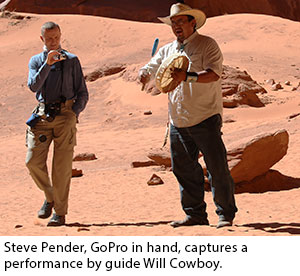 Mystery Valley is right next to Monument Valley, which features the mesas and buttes made famous in John Ford/John Wayne flicks like “She Wore A Yellow Ribbon.” Halina and I had spent the morning with Will and our small tour group soaking in the awe-inspiring views in Monument Valley. Then, after lunch, Will drove us into what he called his “backyard,” a place accessible only by Navajos or by groups with Navajo guides.
Mystery Valley is right next to Monument Valley, which features the mesas and buttes made famous in John Ford/John Wayne flicks like “She Wore A Yellow Ribbon.” Halina and I had spent the morning with Will and our small tour group soaking in the awe-inspiring views in Monument Valley. Then, after lunch, Will drove us into what he called his “backyard,” a place accessible only by Navajos or by groups with Navajo guides.
In addition to sharing his musical culture with us, Will took the time during our day together to chat about Navajo traditions and beliefs. During one of those chats, he touched on the subject of family stories. Navajo children, Will told us, start learning family history from their elders at a very early age, and continue hearing these stories until they know them by heart. It then becomes their responsibility to pass along this knowledge to their children and grandchildren.
Now, we’re not talking about tales that cover a generation or two. Navajo family stories can span hundreds and even thousands of years. As Will told us, it’s thanks to his family stories that he knows his people originated in Siberia. Talk about knowing where you came from!
There are many things we can learn from Native Americans, like the Navajos, and one of them is certainly the importance of preserving, sharing and celebrating family stories. This will certainly require a change in the mindset of our “here today, gone tomorrow” culture, where kids are lucky if they even know their grandparents. Being a driver for this change is part of Family Legacy Video’s mission, and with each completed video biography, I feel we’ve helped another generation to know where it came from.
World War II bombing runs by B-17s, collecting maple syrup in Quebec, commercials for the Ford Edsel; all of these are examples of historical footage used in past Family Legacy Video® video biographies. There’s an amazing abundance of historical images, both still and moving, from an array of sources, that can help enhance and illuminate the life stories related by family storytellers. A hallmark of Family Legacy Video’s Deluxe Legacy Videos is the use of archival images that lend a “big budget” documentary feel to the productions.
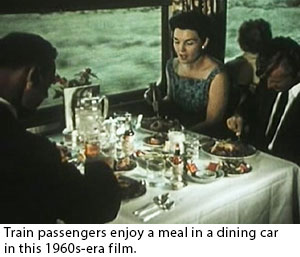 Archival images and footage do come with a cost, however. First, there’s the time it takes to research, locate and secure the material. This time alone adds to the cost of video biography. But the footage itself can be pricey. That’s why it’s nice to find a resource for free, public domain footage. One that’s been helpful to me over the years is the Internet Archive. The Internet Archive, a 501(c)(3) non-profit, is a digital online repository of both still and moving images. You’ll find lots of old government and promotional films there, many of them in the public domain. Clips are available for download in a variety of formats. Due to compression, the video is not necessarily pristine, but it is free, and if you’re a creative editor you can always find ways to dress it up in post.
Archival images and footage do come with a cost, however. First, there’s the time it takes to research, locate and secure the material. This time alone adds to the cost of video biography. But the footage itself can be pricey. That’s why it’s nice to find a resource for free, public domain footage. One that’s been helpful to me over the years is the Internet Archive. The Internet Archive, a 501(c)(3) non-profit, is a digital online repository of both still and moving images. You’ll find lots of old government and promotional films there, many of them in the public domain. Clips are available for download in a variety of formats. Due to compression, the video is not necessarily pristine, but it is free, and if you’re a creative editor you can always find ways to dress it up in post.
I’ve found shots in some films at the archive that I couldn’t find anywhere else – and that perfectly fit the bill. So check out the Internet Archive; you may find it a valuable free source of images or just a place to go to watch some really neat old films.
Organization and preparation are the keys to any successful video shoot, and legacy video interviews are no exception. This is especially true when planning the questions for your video biography session. After all, your life story is unique, and only a set of custom questions designed to elicit the details of your life will do. The key to crafting those questions is the preinterview.
Basically, a preinterview is a discussion we’ll have as we begin planning for your shoot. It takes the form of a casual conversation, or conversations, and can be conducted either face-to-face or over the phone. During the preinterview, I’ll learn just what you want to talk about, as well as the details of your stories. I’ll use that information to draft questions that relate specifically to you and your stories.
Doing my homework with a preinterview helps us to work efficiently once the cameras are recording. Not only will I know what to ask, but because I’ll already be aware of the details of your stories, I’ll be able to prompt you for more information if I catch you overlooking any important facts.
So, as you see, a little homework in the form of a preinterview can guarantee a smooth, successful and enjoyable interview – for all involved.
One of my responsibilities as your video biographer is to usher you through the production process and make the experience as easy for you as possible. That includes taking the time to learn your stories, crafting custom questions for your on-camera interview, and making sure you look and sound your very best on screen. If we’re working together to create a Premium or Deluxe Family Legacy Video®, another critical part of the process involves collecting the photos and other images we’ll use to illustrate your stories and give your legacy video that big-budget documentary look.
So, what kinds of images are we talking about? This list will give you an idea:
• Still photos
• Newspaper/magazine clippings
• Diplomas
• Wedding announcements
• Plaques
• Trophies
• Medals
• Paintings
• Drawings
• Letters
• Keepsakes
• Souvenirs
• Childhood toys
• Family videos (or films transferred to video)
Pulling together all these visuals may appear daunting at first. And there’s no getting around the fact that you’ll need to help with some of the work. Here’s how we’ll collaborate to collect the visuals that’ll help make your video biography so special.
WHAT FAMILY LEGACY VIDEO WILL DO.
After we wrap up your preinterview, I’ll draft what I call an Initial Wish List. This is simply a list of photos and other images I think would be great to accompany the stories you’ve told me. I fully realize you may not have all, or sometimes even most, of the items on the list; it’s just something to help you start your search.
WHAT YOU’LL DO.
You’ll go through your albums, shoeboxes and other archives to see just what you have that’s on the Initial Wish List. You may also want to contact family members to see what visuals they may have. Sometimes you’ll discover photos you forgot about and that will stimulate other stories we can cover during your interview. While the visuals search can be a bit time-consuming, it’s far from being drudgery. Think of it as a process of exploration and discovery. I guarantee you’ll have fun! You’ll need to set aside the photos you find. If possible, make notes in pencil (or use sticky notes) on the back of each photo regarding dates, places, and people. If labeling the photos is too much of an effort for you, we can add some time to do this together after we record your interview.
WHAT FAMILY LEGACY VIDEO WILL DO.
After reviewing the visuals you’ve collected, I’ll either scan or shoot them at your location, at the Family Legacy Video office in Tucson, Arizona, or a combination of both. I fully understand that you may have photos or other family heirlooms that may be too fragile to ship or that you don’t feel you want to part with. That’s quite alright; I’ll certainly respect and accommodate your wishes. If the budget allows, I can arrange to have an extra crew member whose job is to scan your photos while we’re conducting your interview.
THE FINAL WISH LIST.
It’s not usual to get ideas for additional visuals after shooting your interview. If this is the case, I’ll send you a Final Wish List detailing the extra items I’d like. Again, you may or may not have some or even all the items on the list. But heck, it doesn’t hurt to ask. If you can provide extra material, we’ll arrange to ship it to the Family Legacy Video office. Or, if you have a family member or friend with a scanner, I’ll send you the dimensions I require and you can then either e-mail or snail-mail the digital files to me.
THAT’S ALL THERE IS.
Of course, there’ll come a time (usually after you receive the Final Wish List) when I need you tell me I’ve gotten all the visuals you can provide. Once I get that word, I’ll focus on using the images I have to their greatest effect.
So don’t let the prospect of having to comb through your family archives stop you from pursuing your video biography project. I guarantee I’ll make the process as easy on you as possible. Plus, you’ll have the satisfaction of knowing you’ve given your family photos and other visuals new lives that will enlighten and delight generations of your family to come.